The Tasmanian wedge-tailed eagle has the widest wingspan of any living eagle, reaching an impressive 2.84 meters (9.3 feet). The harpy eagle is the heaviest, with wild females weighing up to 10 kilograms (22 pounds), while the Steller’s sea eagle consistently rivals both in sheer mass and wingspan, making it the largest eagle on average across all measurements.
This article ranks the world’s biggest eagles by wingspan, weight, and body length, focusing on verified maximums from wild individuals. While captive birds may occasionally grow even larger, we highlight wild size data alongside each species’ physical adaptations and conservation status.
Wedge-Tailed Eagle
Aquila audax
- Wingspan: As wide as 2.84 m (9.3 ft).
- Weight: As heavy as 5.8 kg (12.8 lb).
- Body length: Up to 106 cm (41.7 in).
- Where found: Mainland Australia, Tasmania, and southern New Guinea.
- Conservation status: Least Concern; generally common, though Tasmanian subspecies is endangered.
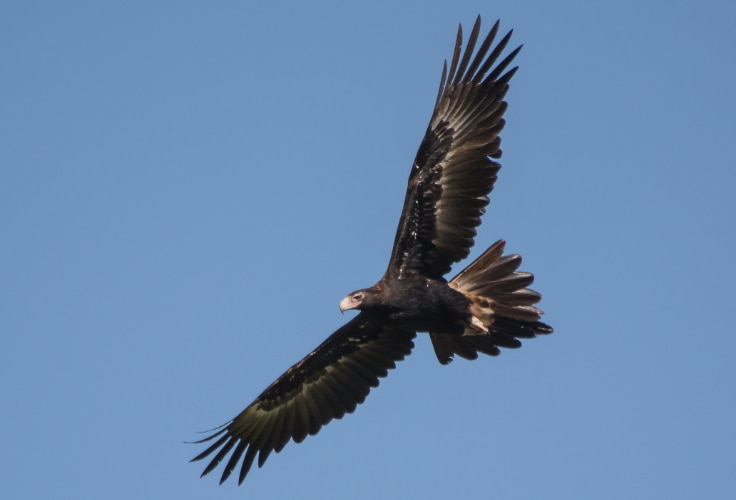
The wedge-tailed eagle holds the record for the widest verified wingspan of any living eagle. Females of the Tasmanian subspecies are the biggest, reaching 2.84 meters (9.3 feet). Occasional reports suggest individuals exceeding 3 meters (9.8 feet), though these remain unverified. Along with this remarkable span, it is the largest bird of prey in Australia. The long, wedge-shaped tail and broad wings carry it effortlessly on thermals for hours, while its talons are strong enough to bring down mammals heavier than itself, including young kangaroos.
This eagle is widespread across mainland Australia, Tasmania, and southern New Guinea, where it occupies nearly all open habitats from deserts to savannas and open forests. It avoids dense rainforests and heavily populated regions. Nests are massive stick platforms built high in tall trees, but in remote areas they may also be placed on cliffs or even on the ground. The species is an opportunistic predator and scavenger. Its diet ranges from rabbits, hares, and young kangaroos to birds, reptiles, and carrion. It is known to hunt in pairs or small groups and to dominate carcasses over other scavengers.
Once heavily persecuted for supposed predation on livestock, the wedge-tailed eagle has recovered and remains common across much of its range. It has even benefited from the introduction of rabbits and roadkill as reliable food sources. Still, the species faces illegal shooting and poisoning, as well as disturbance near nesting sites. The isolated Tasmanian subspecies, A. a. fleayi, is endangered due to its small population and sensitivity to habitat change.
Harpy Eagle
Harpia harpyja
- Wingspan: As wide as 2.24 m (7.3 ft).
- Weight: As heavy as 10 kg (22 lb).
- Body length: Up to 107 cm (42.1 in).
- Where found: Lowland forests of Central and South America.
- Conservation status: Vulnerable; declining due to habitat loss and persecution.

The harpy eagle is the heaviest of all living eagles, with large females reaching up to 10 kilograms (22 pounds). Although slightly shorter in wingspan than some rivals, its sheer bulk and strength set it apart. Its legs and talons are among the most powerful of any bird of prey, allowing it to capture monkeys and other sizeable arboreal mammals. Remarkably, it can lift prey equal to or even exceeding its own body weight, making it arguably the strongest eagle in terms of lifting power.
This species inhabits tropical lowland forests from southern Mexico through Central America and across much of South America, extending south to northern Argentina and Paraguay. Today it survives mostly in large tracts of Amazonian forest, with small remnant populations in Central America. It nests high in emergent trees towering above the canopy, with platforms large enough to support repeated use. Adapted to forest life, the harpy eagle is a sit-and-wait predator that ambushes monkeys, sloths, and other mammals, but it also preys on birds, reptiles, and occasionally large terrestrial animals.
The harpy eagle once ranged widely but has declined across much of Central America due to deforestation and direct persecution. It is still locally common in parts of the Amazon, but its slow breeding rate makes recovery difficult when populations are reduced. Shooting remains a major threat, often driven by curiosity or the mistaken belief that it endangers livestock. Despite its ability to tolerate fragmented landscapes when some forest cover remains, large-scale clearing continues to erode its habitat. Conservation programs, including legal protection and local reintroduction projects, are working to safeguard this iconic forest raptor, though its future remains closely tied to the fate of tropical forests.
Steller’s Sea-Eagle
Haliaeetus pelagicus
- Wingspan: As wide as 2.7 m (8.9 ft).
- Weight: As heavy as 9.5 kg (20.9 lb).
- Body length: Up to 105 cm (41.3 in).
- Where found: Coastal northeastern Asia, from the Russian Far East to Japan.
- Conservation status: Vulnerable; small and regionally declining population.

The Steller’s sea-eagle is the biggest of all sea eagles and the world’s largest eagle on average across all measurements. Females, much larger than males, may reach 9.5 kilograms (20.9 pounds), rivaling the harpy eagle in body mass. Its wings extend to 2.7 meters (8.9 feet), among the widest of any eagle, though higher figures sometimes reported remain unverified. This immense raptor is instantly recognizable by its massive yellow bill, white shoulders, and powerful build.
This eagle inhabits the coasts and river valleys of the Russian Far East, around the Sea of Okhotsk and the Kamchatka Peninsula, with wintering grounds extending south into Japan, Korea, and occasionally China. It breeds in forested valleys near rivers or along rugged coasts, always close to water rich in fish. Nests are huge stick platforms, up to 2.5 meters (8.2 feet) across, placed in tall trees or cliffs. The diet is dominated by salmon and other fish, but it also takes waterfowl, mammals such as hares and foxes, and scavenges frequently at carcasses, including those of seals and deer. In Japan, wintering birds rely heavily on marine fish and deer carrion.
Despite legal protection in Russia, Japan, China, and Korea, the Steller’s sea-eagle faces ongoing threats. Habitat loss from logging and hydropower development, industrial pollution, and lead poisoning from ingested shot continue to pressure the species. Direct persecution by hunters has declined but still occurs. Conservation measures include protected reserves across its breeding and wintering range, with Japan’s Shiretoko Peninsula designated as a key wintering sanctuary. Sustaining this eagle will depend on continued monitoring and the preservation of its coastal and riverine habitats.
White-Tailed Eagle
Haliaeetus albicilla
- Wingspan: As wide as 2.6 m (8.5 ft).
- Weight: As heavy as 8 kg (17.6 lb).
- Body length: Up to 94 cm (37.0 in).
- Where found: Across northern Eurasia, from Greenland to eastern China.
- Conservation status: Least Concern; widespread and recovering after past declines.
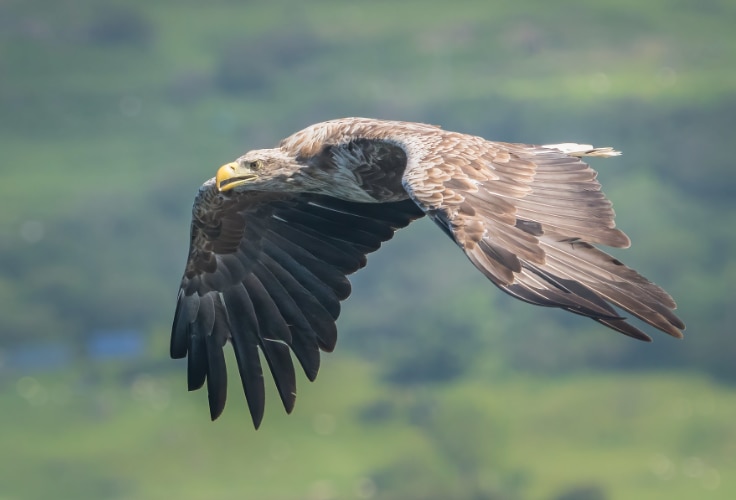
The white-tailed eagle is the largest eagle in Europe, with Greenland females reaching 8 kilograms (17.6 pounds) and wingspans up to 2.6 meters (8.5 feet). Interestingly, males of this species are proportionally larger than in most other eagles, since sexual size dimorphism is less pronounced, making the males among the biggest of any eagle species. With their massive yellow bills, broad wings, and long wedge-shaped tails, white-tailed eagles are imposing hunters and scavengers that dominate many of the aquatic landscapes they inhabit.
This species ranges widely across northern Eurasia, from Greenland and Iceland through Scandinavia and Russia, south to Greece, Turkey, the Caspian region, and northeastern China. It inhabits diverse wetlands and coastal areas, including sea cliffs, large lakes, rivers, and estuaries. Nests are built in tall trees or on cliffs close to water, often reused and enlarged for many years until they reach monumental size. The diet is broad but centered on fish and waterbirds, taken alive or scavenged, supplemented with mammals and carrion. Opportunistic by nature, it steals from ospreys and other raptors and readily exploits fish farms, offal, and deer carcasses.
Once heavily persecuted and poisoned, the white-tailed eagle suffered drastic declines and disappeared from much of western Europe during the 19th and 20th centuries. Populations were further weakened by organochlorine pesticides and heavy metal contamination, which reduced breeding success. Since the 1980s, however, intensive protection and reintroduction programs have reversed the trend, with strong recoveries in Germany, Poland, Norway, and the British Isles. Today the species is re-establishing itself across much of its former range, though it still faces threats from lead poisoning, habitat disturbance, and collisions with wind turbines.
Golden Eagle
Aquila chrysaetos
- Wingspan: As wide as 2.55 m (8.4 ft).
- Weight: As heavy as 7.7 kg (17.0 lb).
- Body length: Up to 102 cm (40.2 in).
- Where found: Across the Holarctic, from North America to Eurasia and North Africa.
- Conservation status: Least Concern; widespread but locally threatened.
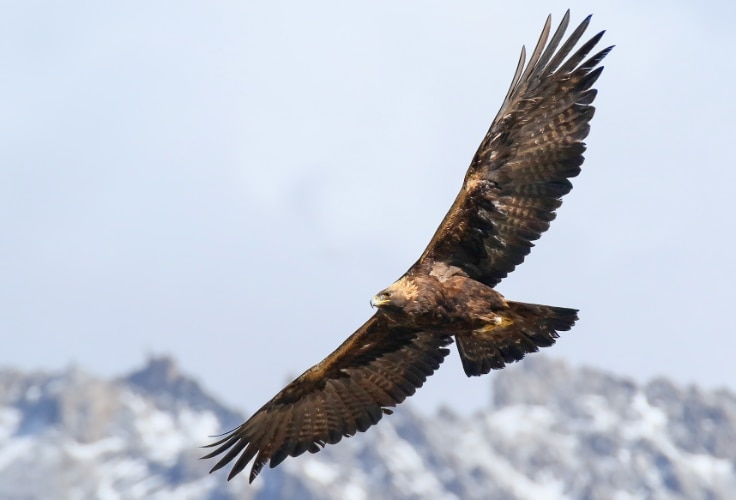
The golden eagle is the largest eagle in North America and one of the most widespread predatory birds in the world. Wild females can reach 7.7 kilograms (17.0 pounds) and 2.55 meters (8.4 feet) in wingspan. While even longer wingspans are reported in Asian birds, such figures are tied to captive specimens. Built for endurance and efficiency, the golden eagle is an expert in flight, soaring for hours on thermals with minimal effort. Its speed and power make it a formidable hunter of mammals and birds across a wide range of habitats.
This species has a vast Holarctic distribution, ranging from North America through Europe and Asia to North Africa, with isolated populations in the Ethiopian highlands. It occupies landscapes from sea level to alpine zones, favoring open terrain such as grasslands, deserts, and mountain slopes, though it also uses forests and tundra. Nests are large stick platforms built on cliffs or in tall trees, often reused for years. Its diet varies widely with geography but typically focuses on medium-sized mammals such as hares, rabbits, and ground squirrels. Golden eagles also take birds, larger mammals including deer fawns, and carrion, particularly in winter.
Historically persecuted by shooting, trapping, and poisoning, the golden eagle suffered significant declines across both North America and Eurasia. With stronger protections in recent decades, many populations have stabilized or increased, though local threats remain. Collisions with wind turbines, electrocution on power lines, lead poisoning from scavenged carcasses, and illegal killing continue to impact the species. Despite these pressures, the species endures as both a cultural icon and one of the most successful large raptors across the Northern Hemisphere.
Bald Eagle
Haliaeetus leucocephalus
- Wingspan: As wide as 2.44 m (8.0 ft).
- Weight: As heavy as 7 kg (15.4 lb).
- Body length: Up to 102 cm (40.2 in).
- Where found: North America, from Alaska and Canada to northern Mexico.
- Conservation status: Least Concern; recovered after historic declines.

The bald eagle is the world’s most recognizable large eagle, famed as the national symbol of the United States. The largest individuals come from Alaska, where females may reach 7 kilograms (15.4 pounds) in weight and 2.44 meters (8.0 feet) in wingspan. Bill size is also unusually variable, with Alaskan birds showing up to twice the bill length of southern populations. Broad wings and slow, deliberate wingbeats allow for efficient soaring, while its formidable size and sharp talons make it a versatile predator and scavenger.
This eagle breeds widely across North America, from Alaska and Canada south throughout the United States and into northern Mexico. It favors aquatic habitats, lakes, rivers, estuaries, and coasts, where fish are abundant. Nests are usually placed in the tallest trees near water but may also occur on cliffs or the ground in treeless regions. Over years of reuse and additions, nests can become monumental, exceeding 2.9 meters (9.5 feet) across and 6.1 meters (20 feet) deep. The diet is dominated by fish but includes waterfowl, mammals, reptiles, and carrion.
After suffering dramatic declines in the 20th century from hunting, DDT poisoning, and habitat loss, the Bald Eagle has staged one of the greatest wildlife recoveries of modern times. Following the DDT ban and decades of protection, its numbers increased by nearly 800% over 40 years. Today, it thrives across much of North America, with especially dense populations in Alaska, Canada, and along major rivers and coasts of the lower 48 states. Despite this success, local threats remain, including lead contamination, habitat encroachment, and occasional illegal shootings.
Martial Eagle
Polemaetus bellicosus
- Wingspan: As wide as 2.4 m (7.9 ft).
- Weight: As heavy as 6.5 kg (14.3 lb).
- Body length: Up to 96 cm (37.8 in).
- Where found: Across sub-Saharan Africa, from Senegal to South Africa.
- Conservation status: Endangered; declining due to persecution and habitat loss.
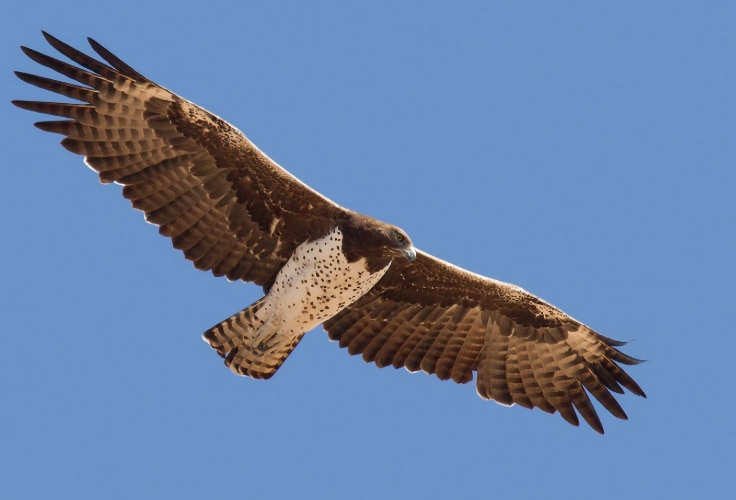
The martial eagle is the largest eagle in Africa and one of the continent’s most formidable raptors. Females reach up to 6.5 kilograms (14.3 pounds) and 2.4 meters (7.9 feet) in wingspan, with some unverified reports of even longer spans. Its great size, coupled with powerful legs and talons, allows it to overpower prey as large as small antelopes and monkeys. Unlike many eagles, the martial eagle spends long periods soaring at high altitude, scanning vast open landscapes for prey, striking in sudden dives with tremendous force.
This African endemic ranges widely across sub-Saharan Africa, from the Sahel to southern Africa. It inhabits open woodlands, savannas, deserts, and grasslands. Nests are large stick platforms placed in the forks of emergent trees, cliffs, boulders, or even power pylons, often visible from afar. The diet is dominated by medium-sized vertebrates, including guineafowl, francolins, waterfowl, monitor lizards, hares, hyraxes, mongooses, monkeys, and antelope calves. Martial eagles also occasionally take livestock and poultry, which has contributed to their persecution.
Despite once being widespread, the martial eagle is now in rapid decline. Persecution through poisoning and shooting, collisions with power lines, and the loss of prey and nesting habitat are the main threats. It persists at low densities, with huge home ranges, even inside large protected areas such as Kruger and Hwange National Parks. Though it is still found across much of its historical range, local extirpations have occurred in parts of southern Africa.
Philippine Eagle
Pithecophaga jefferyi
- Wingspan: As wide as 2.2 m (7.2 ft).
- Weight: As heavy as 8.2 kg (18.1 lb).
- Body length: Around 100 cm (39.4 in).
- Where found: Endemic to the Philippines (Luzon, Samar, Leyte, Mindanao).
- Conservation status: Critically Endangered; fewer than 400 pairs remain.
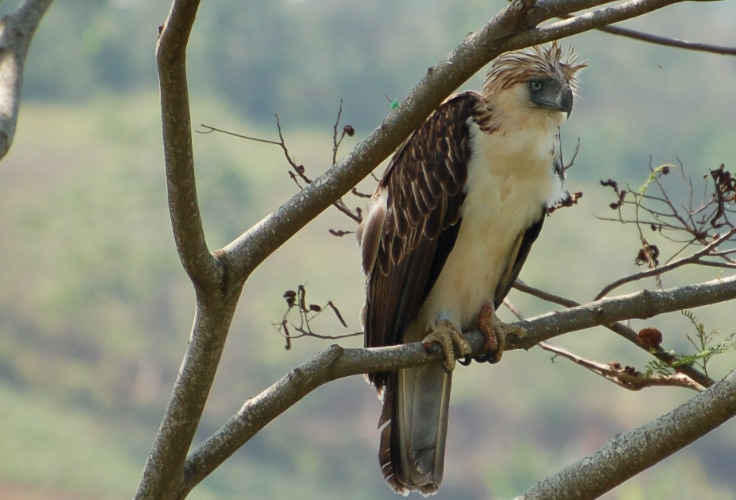
The Philippine eagle is the world’s longest extant eagle, averaging around 100 centimeters (39.4 inches) in body length, with some captive or rehabilitated individuals reaching 112 centimeters (44 inches) or more. While its wingspan is shorter than those of many other large eagles, this is an adaptation for maneuvering through dense tropical forests. Its massive bill, shaggy crest, and piercing eyes make it one of the most striking and distinctive raptors on the planet.
Endemic to the Philippines, the species inhabits the primary dipterocarp forests of Luzon, Samar, Leyte, and especially Mindanao, which holds the bulk of the surviving population. It requires vast tracts of mature forest, from lowland areas up to 2,000 meters (6,600 feet), and occasionally higher. The Philippine eagle feeds on flying lemurs, palm civets, monkeys, monitor lizards, birds, and occasionally deer. It hunts by patiently moving from perch to perch within the canopy and has even been observed using cooperative tactics, with one bird distracting prey while the other strikes.
With fewer than 400 breeding pairs left, the Philippine eagle is one of the rarest and most endangered eagles in the world. Its survival is imperiled by widespread deforestation, hunting, and the fragmentation of remaining forests, which limits juvenile dispersal. Although it breeds relatively successfully where habitat persists, low survival rates of young birds further strain recovery. Conservation efforts, led by the Philippine Eagle Foundation since 1987, include captive breeding, education, and habitat protection.
Verreaux’s Eagle
Aquila verreauxii
- Wingspan: As wide as 2.3 m (7.5 ft).
- Weight: As heavy as 7 kg (15.4 lb).
- Body length: Up to 96 cm (37.8 in).
- Where found: Eastern and southern Africa, with small populations in Arabia.
- Conservation status: Least Concern; stable in many regions but persecuted locally.
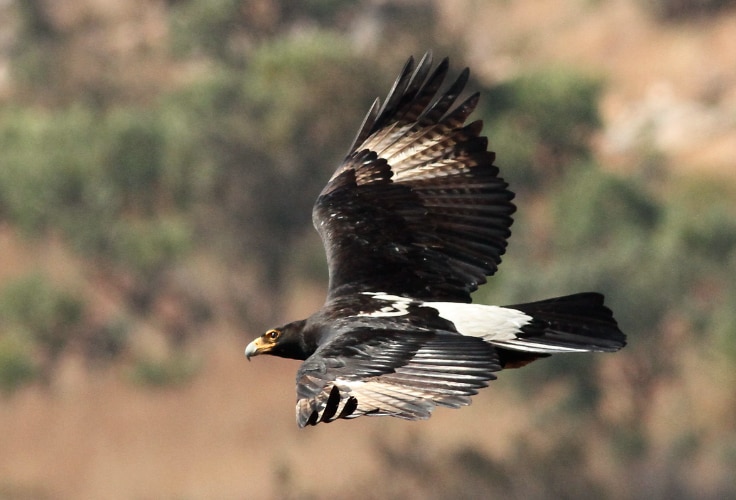
Verreaux’s eagle is one of Africa’s most powerful raptors, nearly matching the golden eagle in size, with females reaching 7 kilograms (15.4 pounds) and wingspans up to 2.3 meters (7.5 feet). Adapted to mountainous terrain, it is instantly recognizable with its striking black-and-white plumage and commanding flight silhouette. Though large and formidable, it is highly specialized, relying heavily on hyraxes for food, sometimes making up over 90% of its diet.
This eagle ranges across much of eastern and southern Africa, from Ethiopia and Sudan through Kenya and down to South Africa, with isolated populations in Namibia, Angola, and the Arabian Peninsula. It inhabits arid and rocky landscapes, including cliffs, gorges, kopjes, and mountain slopes. Nests are massive stick structures, often reused for decades, placed on cliffs, ledges, or occasionally in trees and even on human structures. Pairs may nest surprisingly close together where prey is abundant, and they sometimes hunt cooperatively.
Although widespread and not globally threatened, Verreaux’s eagle faces localized pressures. Persecution still occurs where it is blamed for killing small livestock, and declines have been noted in areas where hyrax populations are reduced by drought, overgrazing, or hunting. In some parts of South Africa, however, it has adapted well to agricultural landscapes and shows high breeding success. Overall, it remains common in rugged, rocky habitats, thriving where its specialized prey base persists.
Crowned Eagle
Stephanoaetus coronatus
- Wingspan: As wide as 2.0 m (6.6 ft).
- Weight: As heavy as 4.7 kg (10.4 lb).
- Body length: Up to 99 cm (39.0 in).
- Where found: Sub-Saharan Africa, from West and East Africa to South Africa.
- Conservation status: Near Threatened; declining due to habitat loss and persecution.
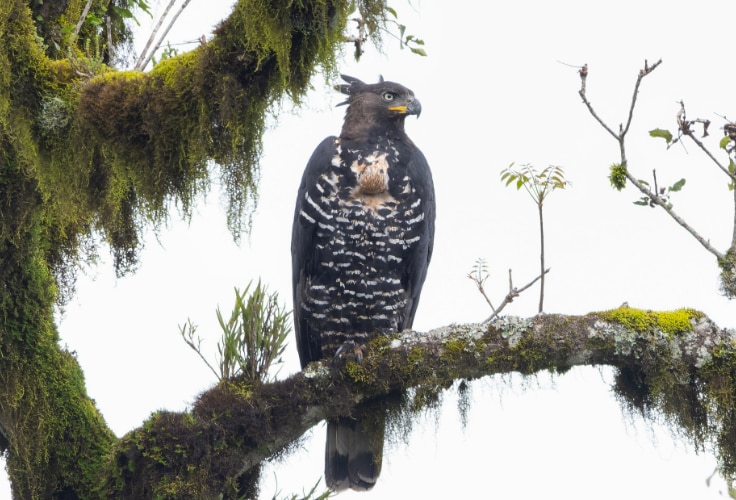
The crowned eagle is the largest forest eagle in Africa and one of the most powerful raptors in proportion to its size. Unlike many large eagles, it is built for dense forest life, with broad wings and a long tail adapted for maneuvering among trees. Known for its ferocity, the crowned eagle is also among the few birds that pose a danger to humans. Adults aggressively defend their nests, and rare cases of predation attempts on children have been documented.
This species is distributed patchily across sub-Saharan Africa, from Senegal and Ethiopia south to South Africa. It inhabits dense lowland and montane forests, as well as riverine woodland and plantations. Nests are massive stick structures, often used for decades, built high in tall forest trees. A formidable ambush predator, the crowned eagle specializes in monkeys and small antelopes, though its prey includes hyraxes, mongooses, bush pigs, and large birds. It is capable of killing animals far heavier than itself, sometimes up to 20 kilograms (44 pounds) or more, which it dismembers and caches in trees.
Although still present across much of its historical range, the crowned eagle is declining in many regions. Deforestation and overhunting of monkeys and antelopes, its primary prey, have reduced populations in West and East Africa. In South Africa it is sometimes persecuted for taking poultry or small livestock, though in some areas it benefits forestry by reducing mammals that damage trees. Despite local adaptations, its reliance on intact forests makes it especially vulnerable to habitat loss.
Largest Eagle That Ever Lived
While the eagles listed above are the biggest, heaviest, and most powerful still found in the wild, the largest eagle in history no longer soars the skies. That title goes to the Haast’s eagle (Hieraaetus moorei), which lived in New Zealand and went extinct roughly 600 years ago.
This huge raptor may have weighed up to 18 kilograms (40 pounds) with a wingspan approaching 3 meters (10 feet). It preyed primarily on the now-extinct moa – giant flightless birds, using talons as large as a tiger’s claws and enough force to kill prey far heavier than itself.
Though gone, the Haast’s eagle remains a striking reminder of the power of evolution and a fitting counterpart to the largest eagles still with us today.



